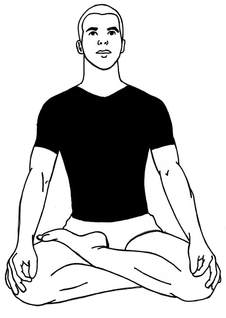|
After describing the 6 obstacles and 6 necessary qualities for success, the Hatha Yoga Pradipika (~1500 CE) goes on to describe 15 postures, the largest number to that point in history. The first 5 postures are below. Many of these old (traditional?) postures have gone out of style and practice in the last hundred or so years. Others are still with us. 1. Swastikasana "Place both soles of the feet inside the thighs and knees. Sit up straight." This is a great posture for breathing and meditation practice, stable but less challenging than the full Lotus. Sadly, as modern western yoga practice has become less seated, the posture has fallen out of popularity. 2. Gomukhasana "Put the right ankle on its left side beside the buttock. Likewise, put the left ankle on its right side." (a) "Place the right ankle next to the left buttock and the left (ankle) next to the right (buttock)." (b) The two instructions above are from different translations of the same verse. The slightly different translations of right and left lead to completely different instructions for the posture. By far the more common usage is the second translation, which is pictured above, with the knees crossed on top of each other. It is unclear, though, which translation is actually accurate or correct. 3. Virasana "Place one foot on top of one thigh, and the other thigh on top of the other foot." In modern yoga practice, this posture has taken on many forms which correspond to this description in varying degrees. The best we can tell, this is describing a Half-Lotus sort of position. 4. Kurmasana "Cover the anus with the crossed ankles." The instruction in the text is quite clear, as pictured above. This posture has fallen completely out of practice as far as we know. The name Kurmasana has been adopted to describe another position for the past 100 or so years, a deep forward bend with the shoulders underneath the knees, pictured below. 5. Kukkutasana
"Settle in Padmasana. Put the hands between the knees and thighs. Place the hands on the earth. Lift into the sky." Of these first 5 postures in this important text, only Kukkutasana is both crystal clear in its instruction and still practiced the same way today. Continue reading about the second group of 6 postures, and the third group of 4 postures. a) Translation by Brian Dana Akers. Published by yogavidya b) Unknown translator. Commentary by Swami Muktibodananda. Published by Yoga Publications Trust.
11 Comments
Wendy
2/5/2018 11:32:21 am
Where can I find the rest of the 15 postures?
Reply
Scott
6/19/2018 06:29:28 pm
There are two more entries with the rest of the postures. Their links are here: http://www.ghoshyoga.org/blog/hatha-yoga-review
Reply
6/19/2018 06:49:13 am
Which of the correct name of the text",Hatha Yoga Pradeepika" or " Hatha Pradeepika"
Reply
Scott
6/19/2018 06:27:54 pm
To the best of my knowledge, the original name of the text is the Hathapradipika. Subsequent texts most commonly have referred to it as the Hatha Yoga Pradipika, so that has become the de facto name. Most people now call it the Hatha Yoga Pradipika, but I think people will know what you're saying if you use either name.
Reply
6/17/2019 01:26:58 am
very nice information. please keeps sharing more post. I love to read this post. Thank you
Reply
Tejashawini
7/9/2020 09:20:07 pm
Good
Reply
7/26/2022 05:51:39 am
First time here at your blog and wanted to say i enjoyed reading this
Reply
Leave a Reply. |
AUTHORSScott & Ida are Yoga Acharyas (Masters of Yoga). They are scholars as well as practitioners of yogic postures, breath control and meditation. They are the head teachers of Ghosh Yoga.
POPULAR- The 113 Postures of Ghosh Yoga
- Make the Hamstrings Strong, Not Long - Understanding Chair Posture - Lock the Knee History - It Doesn't Matter If Your Head Is On Your Knee - Bow Pose (Dhanurasana) - 5 Reasons To Backbend - Origins of Standing Bow - The Traditional Yoga In Bikram's Class - What About the Women?! - Through Bishnu's Eyes - Why Teaching Is Not a Personal Practice Categories
All
Archives
May 2024
|












 RSS Feed
RSS Feed